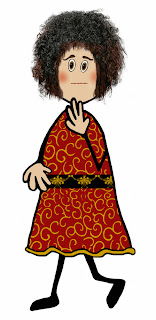 Google Images are not images owned by Google, so they give no permission for the use of images shown on Google Images. Google images is nothing more than a search engine that indexes images that can be found on the web.
Google Images are not images owned by Google, so they give no permission for the use of images shown on Google Images. Google images is nothing more than a search engine that indexes images that can be found on the web.That does not mean you have permission to use them. Every image is protected by copyright unless it's listed in the Public Domain (must say so); or unless it's licensed as Creative Commons (in which case you must follow the licensing terms) or, unless the copyright holder (ie: the owner of the image - the artist, the photographer, the creator) has listed it as free to use. The same would hold true for any image search engine (like yahoo or bing) - since they do not own the images, they cannot grant you usage rights for the images. The only one who can give you authorization to use the images is the owner/creator of the image.
And there are, in fact, quite number of websites that offer free images for bloggers and website owners, incuding some of the more popular micro-stock sites (Shutterstock to name at least one). They require you to sign up and you are restricted to certain uses and to the images they offer weekly/daily for free, but they are images produced by professional photographers. There really is no excuse for using images without permission when many sites offer them for free. Even Flickr has a multitude of images licensed for use under Creative Commons. You just have to read the appropriate licenses and follow them.
Lots of people don't really understand copyright law very well, which isn't surprising because it's pretty complicated. Further reading (below) includes answers from a lawyer; bloggers who have been sued for using other's images without permission; and famous people or companies sued for not acquiring permission.
http://www.legalcentral.com/blog/can-i-be-sued-for-using-other-peoples-pictures-on-my-website/
http://www.roniloren.com/blog/2012/7/20/bloggers-beware-you-can-get-sued-for-using-pics-on-your-blog.html
http://www.prdaily.com/Main/Articles/How_using_Google_Images_can_cost_you_8000_14912.aspx
http://tamaratattles.com/2013/01/11/housewives-blogger-sued-by-new-jersey-media-group-for-copyright-violation/
http://www.alaskadispatch.com/article/20130913/sarah-palin-and-sarahpac-sued-over-use-copyrighted-911-photo
http://fstoppers.com/photographer-sues-celebrity-blogger-perez-hilton-for-copyright-infringement
http://blog.seattlepi.com/timothymccormack/2012/01/26/copyright-infringement-letter-for-images-on-your-website/
http://womeninbusiness.about.com/od/copyrightlaws/a/Can-I-Ignore-A-Getty-Settlement-Demand-Letter.htm
Also note that although Fair Use does exist in the Copyright Law (US), there is no guarantee that your use of the image would be considered Fair Use, and AdSense may not consider Fair Use at all if you must file an appeal because your account was disabled. Adsense's copyright policies don't really mention Fair Use, and saying that Fair Use gives you authorization to use images/text/video clips is more likely to fail with Adsense.
One other thing to note: using a screenshot of someone's image is not really an option unless you have permission from the image owner, so it's really not that much different than having to acquire permission for the image itself. Screenshot use may be dependent on the actual use of the image, but if you simply open someone else's image to full size, and take a screenshot, then try to use that as a free wallpaper or to sell it, or use it as your own ... the answer to that is that this would just as likely get you sued as using the actual image.
If you were using a screenshot of a page that contained an image, but the primary focus isn't the image, you may possibly get away with fair use, if your use of the screenshot falls under fair use, but it isn't something I would rely on.
Fair Use
http://www.copyright.gov/laws/
http://www.copyright.gov/fls/fl102.html
"Section 107 contains a list of the various purposes for which the reproduction of a particular work may be considered fair, such as criticism, comment, news reporting, teaching, scholarship, and research. Section 107 also sets out four factors to be considered in determining whether or not a particular use is fair.
So even if you think your use falls under the "Fair Use" part of the Copyright law, if the image owner doesn't think so, you may find yourself in court facing a lawsuit, or settling the claim by paying the required fees. If you want to fight the claim, then you'd be required to face the court. Because that's how it works. The cost of a court case and a lawyer is probably far more than the value provided by using the image, or paying to license an image from a stock site. Today, micro stock sites license images at an affordable rate, sometimes only $1 an image. If you can't afford that, you can't afford to go to court over a Fair Use case.The distinction between what is fair use and what is infringement in a particular case will not always be clear or easily defined. There is no specific number of words, lines, or notes that may safely be taken without permission. Acknowledging the source of the copyrighted material does not substitute for obtaining permission."
- The purpose and character of the use, including whether such use is of commercial nature or is for nonprofit educational purposes
- The nature of the copyrighted work
- The amount and substantiality of the portion used in relation to the copyrighted work as a whole
- The effect of the use upon the potential market for, or value of, the copyrighted work
Celebrity & Famous People
For "famous persons", there's a clause that says celebrities have the right to earn from promotional images of themselves ... well, something to that effect (it's called the Right of Publicity). Images of most celebrities are licensed by someone, so whether it's their agent, or the studio, or themselves, they shouldn't be reproduced without permission.
In cases like magazines where celebrity images appear, it can be handled in a lot of ways. The magazine pays for the photoshoot and copyright ownership, and famous person signs a release so the magazine can use it. But what happens after the magazine uses it depends on what the release said that was signed by the celebrity. Some are exclusive use only, some may not be, but only the entity that holds the right to the model release and copyrights has the right to provide the authorization for use of the image. And not all magazines may arrange their own photoshoots, some may license some of the images in their magazines from stock sites, like Getty, in which case even the magazine must comply with the license terms they paid Getty for.
If an image is issued by the copyright holder or representative (authorized) as a press package, it would likely contain licensing that allows the image to be used in only certain ways, so if you rely on press releases and publishing packages for celebrity images, you must be sure your use of the image (ie: the way you intend to use it) would fit within their guidelines of use or licensing.
It's pretty complicated.
http://www.ehow.com/about_6461739_celebrity-copyright-law.html
http://en.wikipedia.org/wiki/Personality_rights
Celebrity Rights: http://nopr.niscair.res.in/bitstream/123456789/11021/1/JIPR%2016(1)%207-16.pdf
Fan Fiction: http://en.wikipedia.org/wiki/Legal_issues_with_fan_fiction
Adsense's Thoughts on Copyright
Equally important for Adsense publishers (or perhaps more so) is AdSense's own policy on copyright, which essentially says if you don't own it, and don't have permission to use it ... just don't use it. The bigger issue is sites which are composed solely of someone else's text, or someone else's images/videos. As well as violating Adsense's own copyright policy, these sites would also violate Webmaster Guidelines which can be a reason for seeing ad serving disabled to your site, or might result in your entire account being disabled if you have multiple sites that all use contents from someone else.
Both Adsense and Webmaster Guidelines expect you to use an image appropriately. When you use an image belonging to someone else, you either acquire permission or make sure of it's free use licensing. You also use it to illustrate your own original contents, you don't use them as the sole purpose for the existence of your website. In other words, your use of images needs to be accompanied by your own useful and original contents. Your site shouldn't consist entirely of images/text/videos you don't own, or didn't create.
by J.Gracey Stinson























